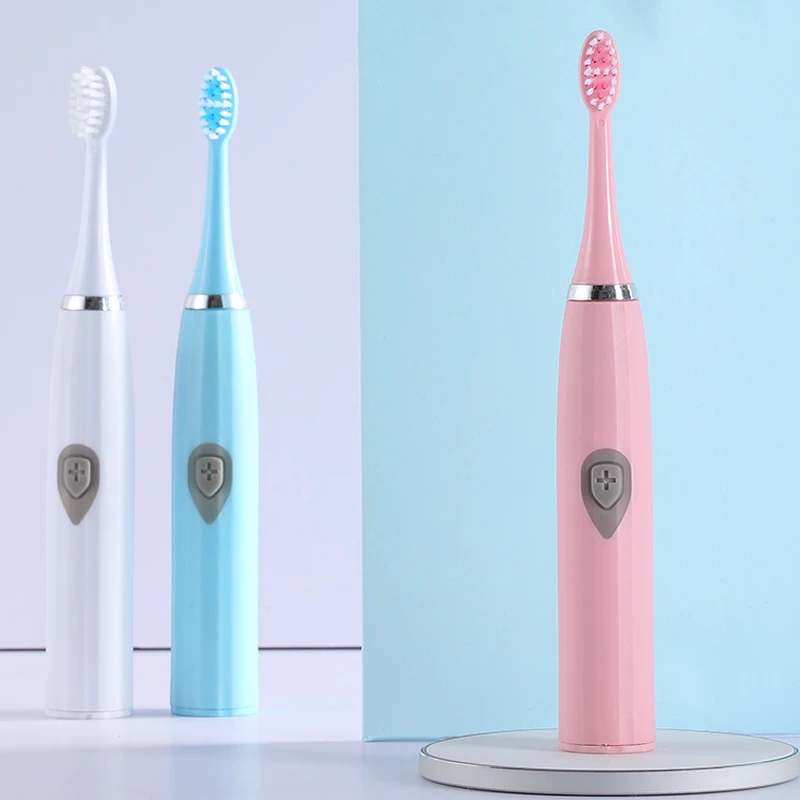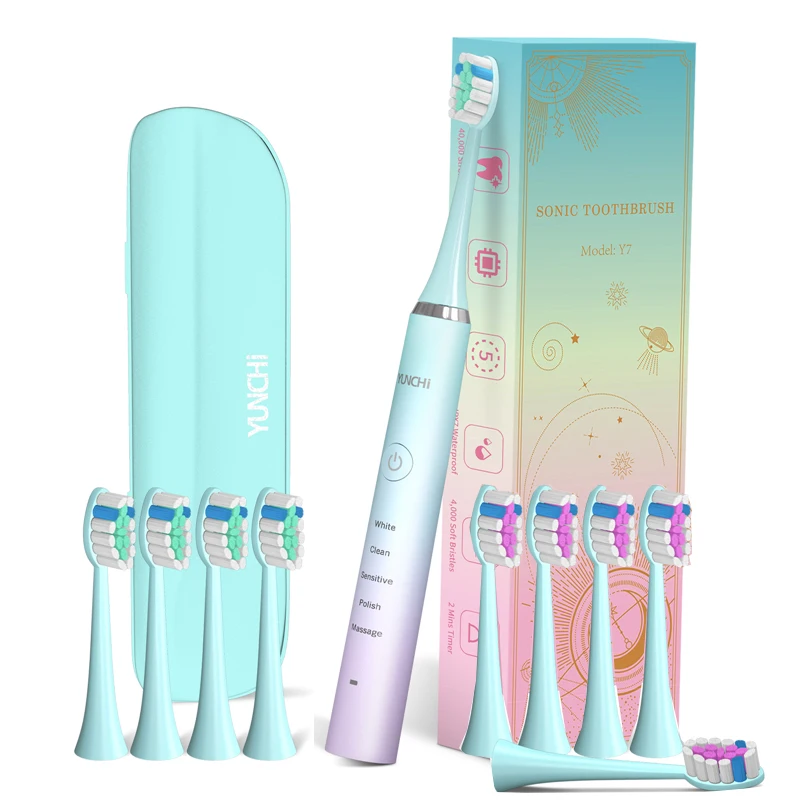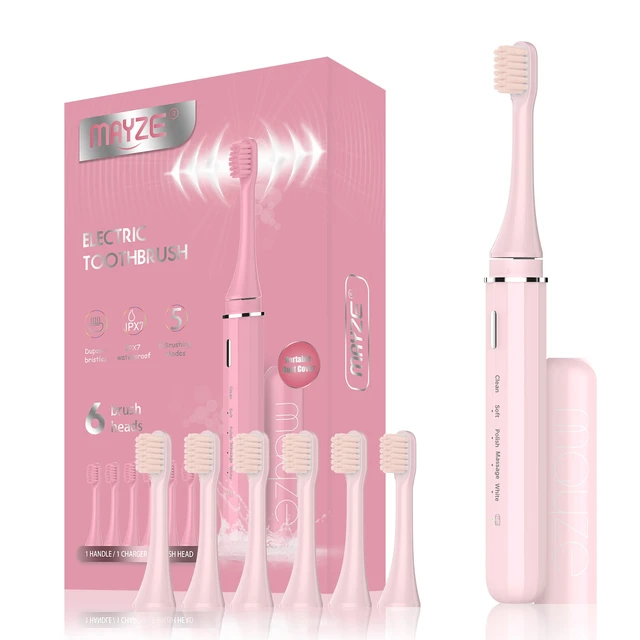The Basics of Electric Toothbrush Technology
Transitioning from a manual toothbrush to an electric one can elevate your oral care routine. Electric toothbrushes harness advanced technology to assist in providing a more effective clean than manual brushing alone. Here, we delve into the basic mechanisms behind these devices and how they improve dental health.

Understanding Oscillating-Rotating Technology
Oscillating-rotating technology is a key feature of many electric toothbrushes. This technology involves a brush head that moves in a circular motion. It spins back and forth to break up plaque and sweep it away. This action is different from the manual side-to-side brushing.
The motion is designed to mimic professional cleaning tools used by dentists. Electric toothbrushes with oscillating-rotating heads can reach tight spaces between teeth. They also massage the gum line gently. Such toothbrushes are often recommended by dental professionals. They may help reduce the risk of gum disease and improve overall oral health.
Electric toothbrushes with this technology do most of the work for you. You need only to guide the brush head to all areas of your mouth. This means you can focus on positioning rather than scrubbing. Proper usage of these toothbrushes can lead to healthier teeth and a brighter smile.
Choosing the Right Electric Toothbrush
Choosing the right electric toothbrush can impact your oral health significantly. Here are factors to consider when selecting an electric toothbrush for your dental routine.
Key Features to Look For
When evaluating electric toothbrushes, several key features should guide your decision:
- Oscillating-Rotating Heads: Look for toothbrushes with oscillating-rotating heads. They break up plaque effectively.
- Soft Bristles: Choose brushes with soft bristles to prevent gum damage.
- Built-in Timers: A built-in two-minute timer ensures you brush for the recommended time.
- Pressure Sensors: Prevents damage from brushing too hard.
- Different Brushing Modes: Modes designed for sensitive teeth, gum care, or whitening can be beneficial.
- Battery Life: Make sure the toothbrush has a long-lasting battery for convenience.
- Seal of Approval: Products with a dental association seal meet certain standards.
Selecting an electric toothbrush with the right features can help you maintain good oral hygiene and promote healthier teeth and gums. Take your time to find the best match for your personalized oral care needs.
Essential Brushing Techniques with an Electric Toothbrush
Learning how to use an electric toothbrush correctly can greatly enhance your oral hygiene. Here’s how you can perfect your technique and make the most out of your electric toothbrush.
Positioning and Movement for Optimal Cleaning
Proper positioning and movement are key to effective brushing with an electric toothbrush. Follow these steps to get optimal cleaning:
- Hold the Brush Correctly: Grip the brush handle firmly but gently. Hold it at a slight angle to your teeth, typically around 45 degrees to the gum line.
- Gentle Movements: Let the brush head do the work. Move it slowly across each tooth surface without pressing too hard. The bristles should contact the teeth and gums lightly.
- Cover All Areas: Make sure to clean each section of your mouth. That includes the outer surfaces, inner surfaces, and the chewing tops of your teeth.
- Take Your Time: Spend at least 30 seconds on each quadrant of your mouth. This ensures you clean all areas equally.
- Avoid Scrubbing: Unlike manual brushing, you should not scrub. Scrubbing can harm your tooth enamel and gum line. The electric toothbrush provides the necessary action.
- Brush Tongue and Cheeks: After your teeth, gently use the brush head to clean your tongue and the inside of your cheeks. This can help reduce bad breath-causing bacteria.
By mastering these techniques, you’ll be able to remove more plaque and reduce the risk of tooth decay and gum disease. A good electric toothbrush can make brushing simpler and more efficient. Always remember to replace the brush heads regularly for the best results.
The Importance of Two-Minute Brushing
Brushing for two minutes is crucial for dental health. This time ensures a complete clean for all teeth areas. Dentists worldwide agree that two minutes is the minimum time to brush effectively. This period allows enough time to remove plaque, combat bacteria, and protect your teeth from decay. By spending 30 seconds on each quadrant of your mouth, you cover all bases. This practice also aids in preventing gum disease and maintains fresh breath.
Consistency with two-minute brushing can improve oral hygiene. This method is a strong defense against cavities and tooth loss in the long run. Therefore, committing to this duration each time you brush is a key aspect of oral care.
Utilizing Built-in Timers for a Thorough Clean
Electric toothbrushes often come with built-in timers. These timers help you brush for the full two minutes. This feature is a helpful reminder to brush each section of your mouth thoroughly. When you start brushing, the timer begins and signals when two minutes are up. This helps ensure you spend enough time on each tooth. Now, you do not have to guess or constantly watch the clock. You can relax, knowing you are getting a dentist-recommended clean with every brush. The timer promotes discipline in sticking to a proper brushing routine. Over time, this may improve your overall dental health.
 Caring for Your Electric Toothbrush
Caring for Your Electric Toothbrush
To keep your electric toothbrush in top condition, proper care is essential. Not only does this help maintain oral hygiene, but it also ensures the longevity of the device. Here’s how you can care for your electric toothbrush.
Maintenance and Replacement of Brush Heads
Regular maintenance of your electric toothbrush is crucial for effective cleaning. Here are some simple steps to follow:
- Clean the Brush Head: After each use, rinse the brush head thoroughly under water to remove toothpaste and debris.
- Dry the Brush Head: Shake off excess water and let the brush head air dry to prevent mold growth.
- Detach and Clean the Handle: Occasionally, remove the brush head and clean the handle with a damp cloth.
- Store Properly: Keep your toothbrush upright in a holder where it can dry out, away from direct contact with other brushes.
Brush heads are not designed to last forever. It’s important to replace them regularly for the best cleaning results:
- Replace Every 3-4 Months: Swap out your brush head every three to four months, or sooner if the bristles become frayed.
- Look for Wear Signs: If bristles lose their firmness, it’s time for a new brush head.
- Consider Your Usage: Heavy brushers may need to replace their brush heads more frequently.
Adhering to these maintenance and replacement guidelines will help you brush your teeth effectively with an electric toothbrush and promote better dental health.
Brushing Tips for Sensitive Teeth and Gums
For those with sensitive teeth and gums, brushing can sometimes be a challenge. Here’s how to ensure a gentle yet effective brush:
Gentle Pressure and Specialized Modes for Comfort
- Use a Soft Touch: Always apply gentle pressure when brushing. Easing up on the grip can prevent irritation.
- Opt for Soft Bristles: Electric toothbrushes with soft bristles are ideal. They are gentle on sensitive gums and teeth.
- Special Modes: Use electric toothbrush modes designed for sensitivity. These provide a soft clean without discomfort.
- Warm Water: Start with warm water on the brush head. It can make the experience more comfortable for sensitive teeth.
- Take It Slow: Move the brush head slowly across your teeth. Allow the bristles to gently sweep away plaque.
- Listen to Your Teeth: If you feel discomfort, ease up further or switch to a softer setting.
Using these tips, you can brush effectively even with sensitivity issues. Remember, choosing the right brush and technique makes all the difference.
Additional Oral Hygiene Tips
Beyond brushing your teeth, other practices can boost your oral hygiene.
Tongue Cleaning and Using Mouth Rinse
To keep your mouth extra fresh and clean, remember these two tips:
- Clean Your Tongue: After brushing, gently brush your tongue too. This removes bacteria and freshens breath. Use the brush head or a tongue scraper for the best results.
- Use Mouth Rinse: Swish with an antiseptic mouth rinse after brushing. It reaches areas your toothbrush might miss and helps reduce bacteria.
Using these additional tips can help you maintain a healthier, cleaner mouth.
 Advantages of Electric Toothbrushes for Children
Advantages of Electric Toothbrushes for Children
When it comes to children and brushing, simplicity and enjoyment are key. Electric toothbrushes offer several advantages that can make brushing more appealing to kids and encourage good oral hygiene habits from a young age.
Making Brushing Fun and Effective
Electric toothbrushes can transform a routine task into something children look forward to. Here are ways these toothbrushes make brushing fun and effective for kids:
- Interactive Features: Many have lights, sounds, and colors that make brushing exciting.
- Timers: Built-in timers ensure kids brush long enough, usually with music or beeps.
- Smaller Heads: Electric toothbrushes often come with smaller heads, perfect for little mouths.
- Gentle on Gums: They offer soft bristles and gentle motions suitable for sensitive young gums.
- Teach Proper Technique: They help kids learn how to brush teeth with less effort.
- Compatibility with Apps: Some connect to smartphone apps that reward kids for brushing.
These benefits not only make brushing more enjoyable for children but also teach them the importance of oral care. As children grow fond of brushing, they are more likely to maintain these habits, leading to healthier teeth and gums.